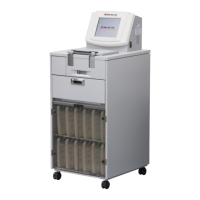Some surface areas of the instrument become hot during operation. When handling
paraffin or removing the basket from the retort, be sure to wear heat-resistant gloves
and/or other protective gears.
The paraffin, paraffin oven, paraffin container and retort are set to high temperatures inside, presenting a
burn hazard. Handle them with care.
When removing the paraffin container, do so slowly and carefully.
If the container is moved violently, molten paraffin may spill. Molten paraffin is very hot, so touching it may
cause burns. The container handles also become hot, so be sure to wear heat-resistant gloves and operate
the handles with care.
You may accidentally touch an infectious source and operate the instrument with the
contaminated hands. Be sure to wear protective gears when operating the instrument.
If you have operated the instrument after handling a pathogen, disinfect the instrument properly. The
disinfection method varies depending on the type of pathogen, so choose a method appropriate for the
pathogen. Also, disinfect/sterilize or otherwise properly treat the protective gears used and then dispose of
them as infectious waste. For the disposal method, follow the applicable regulation and guideline specified
by each institution, country or region.
Keep enough distance when opening the retort lid, especially when the reagent is hot.
Also, be careful not to inhale vapor.
Exercise due caution when handling reagents. Follow the relevant regulations and
guidelines in your country or region and take proper measures to protect the operator,
such as wearing protective gloves, mask and/or safety goggles.
Some reagents are toxic to the human body. Some reagents are very flammable, combustible, and/or
harmful to human body. Use protective gears that are resistant to all reagents on the reagent list.
Reagents in the reagent bottles evaporate and diffuse. When storing the reagent bottles
outside the instrument, choose a well-ventilated place.
Even when the caps on the reagent bottles are closed, evaporation of solution cannot be prevented
completely. Accordingly, if reagent bottles containing reagent are to be stored outside the instrument,
choose a place where ventilation equipment is available (such as inside a draft chamber). Also, be careful
not to let the reagent bottles tip over. Follow the applicable regulation specified by each institution, country
or region and be careful not to let the concentration of each reagent exceed the standard concentration limit
of the applicable substance.
Sterilize any potentially infectious waste material or infectious medical waste and then
dispose of it according to the applicable regulation or guideline in the country or
region.

